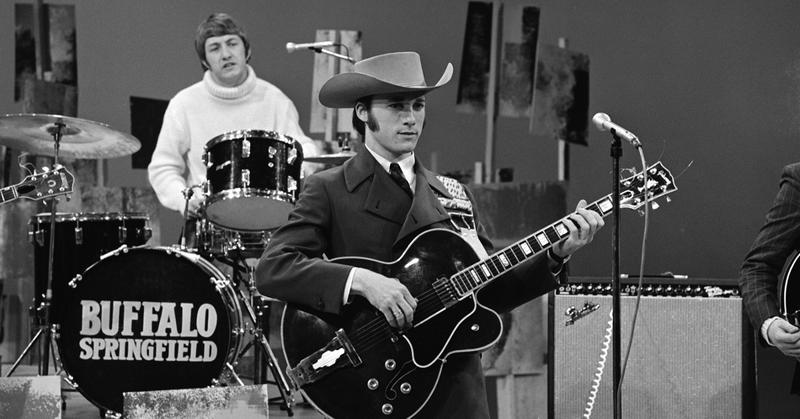1966: Buffalo Springfield Warns Us To 'Stop, Children...' In 'For What It's Worth'
By | May 28, 2019

"There's something happening here / What it is ain't exactly clear..."
The ominous words and high, lonely guitar notes of Buffalo Springfield's "For What It's Worth," followed by the cautious line "Stop, children, what's that sound" make it a '60s anthem. It seems to sum up a mood that was permeating the country -- even though Stephen Stills wrote it about a local Los Angeles event, the "Sunset Strip Riots" of 1966.
"For What It's Worth" (sometimes parenthetically knows as "Stop Hey What's That Sound") also takes a humble observer's viewpoint of a situation -- its title, which appears nowhere in the lyrics, is the equivalent of "It's just my opinion" or "Not for nothing..." -- this is one man's take on a tense scene he admits he doesn't understand.

Buffalo Springfield, formed in 1966, were part of the emerging country-rock scene and also dabbled in psychedelia. The band lasted about two years, and during their brief time together, they recorded three albums and had one major hit: “For What It’s Worth,” which peaked on the Billboard Hot 100 at #7. Many listeners assumed it was about the Vietnam War, or the clashes in the streets between police and protesters. It's also been associated with the Kent State riot, in which National Guardsmen opened fire on protesters, killing four of them. But that tragic event didn't occur until 1970.
Buffalo Springfield's Beginnings

In 1966, Stephen Stills and Richie Furay encountered Neil Young and Bruce Palmer, who were driving a hearse on the Sunset Strip. Within weeks, Dewey Martin had joined them on drums and Buffalo Springfield was formed. They started playing gigs on the Strip. The group became the house band at Whisky a Go Go and Atco signed them to a four-record deal.
“For What It’s Worth” became a sort of anti-war anthem in the ‘60s. Because the lyrics are open to interpretation, the song can be applied to many situations of unrest. While it was about conflict, it was not written about the Vietnam War.
Where The Title Came From

Stephen Stills wrote “For What It’s Worth” in 1966. As Richie Furay, the guitarist for Buffalo Springfield explained, the title of the song came about when Stills, Furay, and Neil Young were playing new songs for Ahmet Ertegun, the founder of Atlantic Records. According to, Furay, Stills said: “I have another one, for what it’s worth.” Because the title of the song appeared nowhere in the lyrics, Ertegun gave the song the parenthetical subtitle “Stop, Hey What’s That Sound.” This made the song more recognizable. Its title did not reveal its inspiration: an incident on the Sunset Strip.
There’s Something Happening Here

Sunset Strip in the ‘60s was a tinderbox during a time of change. Culture and music were moving away from the Rat Pack era. Party-goers were hanging out in clubs on the Sunset Strip, getting stoned, and clogging the streets. Pandora’s Box, which opened in 1962, was one of the clubs specifically catering to the teenagers, who, according to a 1965 county ordinance, were now permitted to dance in public eating places unaccompanied by an adult.
In 1966, there were about 25 clubs playing live music nightly, and people moved from club to club, frequenting more “adult” entertainment at the end of the night. The numbers of clubgoers on the Sunset Strip had increased substantially, which annoyed local residents and upscale business owners, causing them to complain about the hippies who loitered, spent no money at the high-end shops, and drove away the clientele. Additionally, a contingent wanted to turn the Strip into a financial district, and the counter-cultural crowds detracted from their plans. This led the LAPD to target the teenagers, instituting a 10 pm curfew for anyone under 18.
What it is Ain’t Exactly Clear

Stephen Stills was going to listen to live music on the Sunset Strip when he encountered thousands of kids on Sunset Boulevard.
The teenagers had arranged a rally outside Pandora’s Box and distributed flyers for it. A local radio station announced this peaceful protest. On Saturday, November 12, the event began peacefully with kids sitting, holding hands, and singing in the street. This stopped the traffic. Stills witnessed police arriving on the scene, wearing helmets, and walking in a column four-wide to clear the street. At about 10 p.m., the police became more aggressive with the protesters, pushing some out of the way with nightsticks. Up to 1,000 people rallied peacefully until a fight broke out for reasons unrelated to the curfew. The protesters threw objects at storefronts and vandalized a bus.
Inspired by what he witnessed, Stills quickly composed the song. Buffalo Springfield performed the song at the Whisky a Go Go on Thanksgiving. The “Sunset Strip riots” lasted sporadically for days. Eventually, The nightclubs were forced to close and the teenagers took a final stand as they tried to block bulldozers that were to demolish Pandora’s Box. Ultimately, the teens backed down as the bulldozers seemed willing to crush them too.
